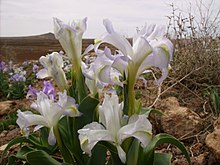|
Iris aucheri
Iris aucheri, the Aucher-Éloy iris, is a species of flowering plant in the family Iridaceae. It is a bulbous perennial in the Juno group of irises (multiple flowers per plant). DescriptionIris aucheri grows to 25 cm (10 in) tall, with crowded lanceolate (lance-shaped) leaves, producing several flowers in late winter or early spring. The flowers may be white, pale blue or dark blue, with a yellow splash on the falls. It has a violet-like scent. GeneticsAs most irises are diploid, having two sets of chromosomes, this can be used to identify hybrids and classification of groupings.[2] It has a chromosomal count of 2n = 24.[3] A study in 2014, was carried out on various species of iris DNA, it found that I. iberica subsp. elegantissima had a purity value of 2.80, compared to 1.26 of Iris aucheri.[citation needed] TaxonomyThe Latin specific epithet aucheri commemorates the 19th century French botanist Pierre Martin Rémi Aucher-Éloy.[4] It was first described as Xiphion aucheri by Baker and then published as Iris aucheri by Sealy in Kew Bull. page 562 in 1950.[5][6] There is a known variant Iris aucheri var. fumosa which was published in 2017.[7] Distribution and habitatIt is native to temperate Western Asia, in Turkey, Iraq, Iran, Syria and Jordan.[5][8] CultivationIris aucheri is cultivated as an ornamental plant in gardens for its showy flowers. It requires neutral or slightly alkaline soil in a sheltered, frost-free spot, or it can be grown in an unheated greenhouse or conservatory, in the UK.[9][10] It is hardy down to USDA Zone 6.[8] In the UK, it has been given a hardiness rating by the RHS of H4: −15 °C (5 °F) (hardy in most locations).[11] This plant species has gained the Royal Horticultural Society's Award of Garden Merit.[11][12] References
|
||||||||||||||||||||||||||||||||||||
Portal di Ensiklopedia Dunia

